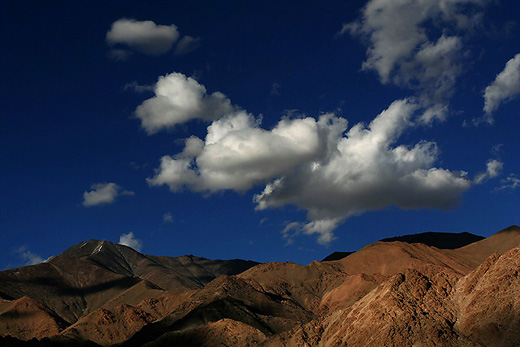Incredible !ndia - Paradise on Earth (Jammu Kashmir Ladakh)
-
Jammu
Romantic green meadows, majestic mountains, bewitching lakes and valleys... Yes, Jammu has the uncanny ability to surprise you at every turn. Tucked snugly between glittering 'shikhars' on ancient temples and holy shrines perched atop hillsides, lie the most picturesque scenes you can ever imagine. But these fascinating places have to be discovered quietly, gently, patiently. For, when they do reveal their inherent beauty, you will indeed be swept off your feet. In fact, you won't believe your eyes.
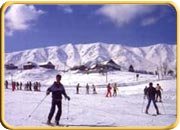
Jammu, the winter capital of the state of Jammu & Kashmir is perched on the first sloping ridge rising from the plains of Punjab. The meandering Tawi river flows along the foothills and in the backdrop is the imposing Trikuta range. Jammu is worth a visit for its temples and for its history as the cradle of Dogra culture. It is the railhead for Kashmir and the starting point for visiting the Vaishnodevi temple at Katra. Jammu has extremes of climate, hot in summer and cold in winter. The best time for a visit is during spring and autumn.
How to get there
By Air: Jammu is connected to Delhi, Jammu and Srinagar. Jammu Airport is 7km from the city. Taxis and autorickshaws are available.
By Rail: Jammu, a major terminus on the rail route, is linked to Delhi through convenient overnight trains. It has excellent rail connections with other parts of the country as well, with many fast and super-fast trains to distant places like Guwahati, Kolkata, Indore, Gorakhpur, Pune, Mumbai, Ahmedabad, Chennai, Bangalore and Mangalore. Jammu Tawi Railway Station is some distance away from the downtown area.
By Road: Jammu, on national highway 1 A, is linked beyond Jalandhar to Delhi on NH 1 and further on to other places. State transport services and private operators have services to most places within the state, including Katra, Udhampur, Patnitop, Srinagar and to places outside like Delhi, Chandigarh, Amritsar and Shimla.
Some important road distances are Srinagar - 293km, Leh - 727km, Chandigarh -363km, Agra - 786km, Patnitop - 112km, Vaishnodevi - 62km, Delhi - 576km.
Accommodation
Good, clean and reasonable hotels are available in Jammu.
Places To See
Temples And Shrines

Amongst the temples in the city, the Raghunath Mandir takes pride of place, situated right in the heart of Jammu. It consists of a cluster of temples which makes it the largest temple complex in Northern India. The inner sanctums of the temples contain gigantic statues of gods and goddesses and numerous 'lingams'. The famous temple of 'Bawey Wali Mata' is inside the Bahu Fort. The Peer Kho Cave Temple, Panchbakhtar Temple and the Ranibireshwar Temple are the other well-known Shiv temples in Jammu.
Other places to see in Jammu are Bahu Fort, Bagh-e-Bahu, Ranbir Canal in Akhnoor, Amar Mahal Palace Museum (designed as a French chateau) and Dogra Art Gallery.
Places Around Jammu
Vaishnodevi Temple
Although Vaishnodevi temple is 61km from Jammu, the aura and influence of the goddess can be felt at Jammu. If any signposts are needed, they are provided by a profusion of images and the greeting 'Jai Mata Di' (Hail, Holy Mother). The greeting turns into a chorus with thousands of pilgrims chanting it enthusiastically during the 'Navratras' in March-April and September-October.
The temple is reached after a trek of 13km from Katra. The path has been paved and facilities like drinking water, snack bars, medical aid, food and accommodation are provided along the route.

Katra town's bazaars offer a colourful scene as shops overflow with 'bhaint' (offerings) for the goddess. The atmosphere at Katra is charged with the spirit and the faith of the pilgrims. The town seems to exist merely to offer services and facilities to them.
How to get there
Nearest airport is Jammu. Besides taxis, buses are available to Katra and Jammu every 10 minutes from the bus stand and railway station. Also Interstate buses are available at places in and even outside the state.
Distances: Katra-Delhi via Una 650km, Udhampur 520km, Chandigarh 410km, Jammu 48km, Patnitop 80km.
Sightseeing: Places connected with the legend of Vaishnodevi include Raghunath Mandir, Kalka Mandir, Bhumika Mandir, Shalimar Park and Chintamani Park.
Accommodation
Good, clean and reasonable hotels are available.
Guest houses: Pilgrim-Centres 'serais' and Dharamsalas are also available.
Patnitop
Relatively unknown, compared to other tourist spots in the state, Patnitop is no less beautiful or serene. If one is aiming to get away from it all for some time, this place is hard to beat.
With all the beauty of a hill station, it is a charming plateau at 1,950m. It's meadown is surrounded by dense woods and the lush greenery of pines. Tracks lead to pockets where time stands still and calm prevails.
How to get there
Buses and taxis are available from Jammu/Katra/Udhampur for Patnitop
Accommodation
Good, clean and reasonable hotels are available.
 Inside the Bawey Wali Mata Temple
Inside the Bawey Wali Mata Temple -
Kashmir
Kashmir is the principal region in the state of Jammu & Kashmir and a favourite destination of the whole world, as unforgettable like ever before. Nestling in the lap of the dazzling, snow-capped Himalayas, the Kashmir valley is undoubtedly a jewel in India's crown. An inspiration for so much art, music and poetry, Kashmir is also a honeymooners' paradise, a nature lover's wonderland and a shopper's dream come true. The Mughal emperors who came here in the summer months described the valley in one word "Paradise".
Over the years, Kashmir has come to love and look after its tourists, fulfilling their every whim. Tourists are everywhere, soaking up all the Kashmir has to offer - the walks, the pony treks, the cable car rides over Gulmarg resort, the shikara rides at sunset on the Dal Lake.

Srinagar
Srinagar, the state capital, is situated at an altitude of 1,730 metres above sea level. The lush greenery of the valley with its terraced rice fields, fruit orchards and swirling waterways spills into the city of Srinagar via the Dal Lake and great avenues of popular and chinar trees. This fresh natural atmosphere combined with the commercial clamor of the old city's twisting medieval streets gives Srinagar a distinctive and vitalizing flavour.
The water world of the Dal and Nagin lakes in Srinagar can be explored in the almost decadent comfort of Shikaras, hand-paddled water taxis. In the mountains, sturdy hill ponies are available for riding or as pack animals to carry trekking supplies on a number of beautiful trekking routes.
How To Get There
By Air: Srinagar is connected to Delhi by flights via Jammu and Leh. Flights are also operated from Delhi to Srinagar. It takes about 40 minutes to reach the Airport if the road is clear.
By Rail: The nearest railhead is Jammu Tawi 305km away. Jammu is connected to all parts of the country by express trains.
By Road: Srinagar, being the only major town linked by road to the rest of the country, is a base for excursions to nearby resorts, for fishing or trekking expeditions. The capital of the state of Jammu and Kashmir is connected by JKSRTC bus services to Jammu, 293km; Leh, 434km; Kargil, 204km; Gulmarg, 52km; Pahalgam, 96km; Chandigarh, 630km; and Delhi 876km. SRTC, Booking Office: Tel: 455107, 472436. Several private companies from Delhi operate buses to Srinagar.
Accommodation
All types of good, clean and reasonable hotels including cottages and bungalows are available.
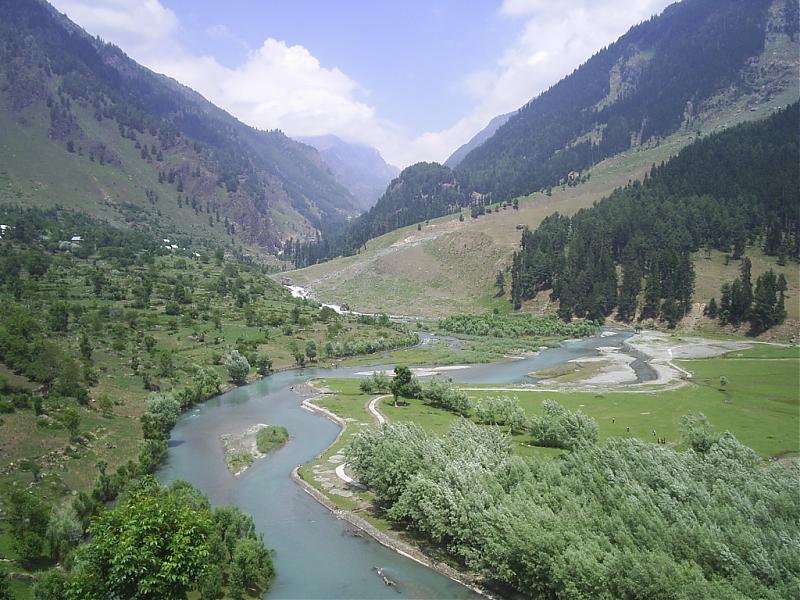
House Boats
Most visitors begin their tour of Jammu and Kashmir in Srinagar, with a stay in a legendary houseboat. Houseboats have been a part of Kashmir's aquatic culture for centuries. Houseboats of all sizes and costs range the banks of the busy Dal Lake and the quieter, cleaner Nagin. Most houseboats on the Nagin and the Jhelum are situated on the banks of the lake, and can be accessed directly from land without the help of a shikara, while all those on the Dal require a shikara to get to and from them. The Dal is famous not only for its beauty, but also for its vibrancy, because it sustains within its periphery, a life that is unique anywhere in the world.


Nagin Lake and Hari Parbat
A beautiful circular drive through apple orchards and rice fields connects Shalimar with the Nagin Lake and the old city of Srinagar. Visitors take this drive to visit the shimmering white marble mosque of Hazratbal, which possesses a hair of Prophet Mohammed. On the lake margin, a short distance from the mosque, is the tomb of Sheikh Mohammed Abdullah, the "Lion of Kashmir". Just beyond Hazratbal and separated from Dal Lake by a causeway, is the Nagin Lake. The Nagin is popular with tourists searching for a quiet vacation. Four swimming boats anchored in the deepest part of the lake offer facilities for swimming, water skiing and surf-board riding. Behind Nagin lake looms the Hari Parbat fortress, atop a small hill built by the Mughal Emperor Akbar. Across the combined lakes from Hari Parbat, on the Takht-e-Suleiman (throne of Solomon) hill is the temple of Sankaracharya. A motor road leads up the hill to this ancient Shiva temple.

Mughal Gardens
The famous Boulevard Road circles the Dal Lake and leads out towards the magnificent Mughal Gardens. The first two gardens - Chashma Shahi and Pari Mahal are to the right of the Boulevard, set into the slope of the circling hills. The two larger gardens, Nishat and Shalimar are located much farther down the boulevard. Nishat is the larger of the two and has an impressive plantation of huge chinar trees on the highest terrace, planted perhaps by the great Mughals themselves. The Shalimar is the more famous garden because of the celebrated romance between its builder, Emperor Jahangir, and his queen Nur Jehan.


Hill Resorts Around Kashmir
Pahalgam is very popular with Indian tourists as the staging point for the famous pilgrimage to the sacred ice lingam in the Amarnath Cave, four days walk to the east. A growing number of foreign tourists go to Pahalgam to relax in surroundings that compare favourably with the Swiss Alps, to play golf on the rough little nine-hole course, or to start off on a number of treks into the high altitude meadows beyond. Tents and pack ponies can be hired in Pahalgam for treks to the 11,800-foot (3,600 meter) Kolahoi glacier, which can be done in three days, or for the arduous, 10-day walk into Ladakh, across the main Himalayan range.
Pahalgam
Pahalgam is Kashmir's premier resort, cool even during the height of summer. A number of hotels and lodges cater to all preferences and budgets, from luxurious to unpretentious trekkers' lodges, including JKTDCs delightfully romantic, fully furnished huts, partially concealed by giant pine trees.
Around Pahalgam are many places of interest, and because the resort is set between fairly steep hills, it is worth hiring a pony rather than walking. Pony fares are posted at prominent locations.
The most beautiful of these is the huge, undulating meadow of Baisaran, surround by thickly wooded forests of pine.
Pahalgam has within it no fewer than eight tiny villages, one of which is Mamal. There is a Shiva temple here, generally considered to be Kashmir's oldest existing temple dating to the 8th century.
Chandanwari, 16kms from Pahalgam, is the starting point of the Amarnath yatra which takes place every year in the month of Sawan (July-August). The destination is the Amarnath cave, believed to be the abode of lord Shiva. Although the road from Pahalgam to Chandanwari is on fairly flat terrain, and can be undertaken by car, from Chandanwari onwards the track becomes much steeper, being accessible only on foot or by pony. 11kms from Chandanwari is the mountain lake of Sheshnag, after which, 13kms away is the last stop, Panchtarni. The Amarnath cave is 6kms away from there. During the month of Sawan, an ice stalagmite forms a natural shivling which waxes and wanes with the phases of the moon.
The State Government makes extensive arrangements every year for the successful completion of the pilgrimage, registering each one of the over one lakh pilgrims, registering pony owners and dandi walas, providing camps enroute, and ensuring safe, comfortable and speedy progress of the yatris.
Fishing
Pahalgam spreads along the banks of the Lidder river, the focal point of interest for fisherman looking for trout.
Trekking
Apart from angling, Pahalgam is also known as the starting point for treks to the surrounding mountains.
Popular treks from Pahalgam are to the Kolahoi Glacier via Aru, Satlanjan and Dudsar Lake, and to the high altitude lakes that dot the meadows and mountain ridges between Pahalgam and Sonamarg.

How To Get There
The two-and-a half hour journey by road from Srinagar can be covered by deluxe buses operating from the Tourist Reception Centre every morning. Taxis can also be hired for the trip, with the choice of a same-day return basis.
Accommodation
Good, clean and reasonable hotels are available.
Gulmarg
A huge cup-shaped meadow, lush and green, with slopes where the silence is broken only by the tinkle of cow-bells, Gulmarg looks like a fantasy set in a film, and not surprisingly, has been the venue of several films. All around are snow capped mountains, and on a clear day you can see all the way to Nanga Parbat in one direction and Srinagar in another.
From Gulmarg, a pony track leads upwards to Khilanmarg, Kongdori and Seven Springs, a couple of hours by pony but longer on foot. From here, across the Apharwat - the peak which looms up from this point - is Alpather Lake, a picturesque alpine lake, frozen till late June.
Slight lower than Gulmarg is the shrine of Baba Reshi, a Muslim mystic saint, whose shrine is visited by people of all faiths.
Gulmarg also has one of the world's highest grreen 18-hole golf course which attract sportsmen in the summer just as its ski runs make it India's premier skiing center in the winter. Several short trekking routes and numerous day walks can be taken from Gulmarg which is only 32 miles (52km) from Srinagar, to the southwest. Gulmarg is the ultimate beginner's skiing resort. You don't need the kind of wardrobe you see on TV - Slacks or a salwar kameez will do fine.
You don't even need heavy woollens, as in Gulmarg you'll be able to hire snowboots, mufflers, woollen socks, windproof jackets and caps. You'll also be able to drift to one of the many ski shops and hire skis, sticks and goggles, find yourself a ski instructor and set off down a slope, cheered lustily by your family while the ski instructor takes a picture of your with your camera!
There are several hotels, (two of them being luxury, several being comfortable) in addition to JKTDC's winterized, fully furnished huts which are great value for money.
Ski Slopes
Come winter and Gulmarg's slopes turn it into a premier ski resort. Not all winter tourists come to ski, some are there to enjoy the snow. Among the multitudes of slopes are a few serviced by ski lifts. Most skiing is centered around these slopes, suited to beginners and intermediate-level skiers, with runs ranging from 200-900 metres.
Instructors are available on payment from the ski shop run by the department of tourism, Government of India. Equipment is of international standard and skiing here is cheaper than anywhere else in the world. For the not-so-adventurous are other snow sports such as tobogganing where no skill is required. Similarly, there are snow-scooters.
Gondola Project
For a fun-filled ride of a most unusual kind, Gulmarg's newly constructed gondola lift from high above Gulmarg, through pine-clad slopes is exhilarating. There are 60 cable cars ferry which takes tourists right up to a height of 3090 mts from 2690 mts at the base.

Trekking
There are several delightful walks around the resort, the most popular being to Khilanmarg 4km away, and Apherwat, 7km away on the same route. Ningal Nallah and Lienmarg are both 10km from Gulmarg, and are popular for day excursions and picnics. Tosa maidan is a three-day trek from Gulmarg. All these journeys can be made on horseback with fixed rates for each. Pony-riding is the chief way of getting around Gulmarg.
How To Get There
Buses and taxis ply between the Tourist Reception Centre in Srinagar and Gulmarg, 56km away.
Accommodation
Good, clean and reasonable hotels are available.
Sonamarg
Sonamarg is a quiet valley, at an altitude of 3000 metres. 80km northeast of Srinagar, almost like heading for an enchanted journey into a wonderland of nature.
Sonarmarg, which means 'meadow of gold' has, as its backdrop, snowy mountains against a cerulean sky. The Sindh meanders along here and abound with trout and mahseer. Ponies can be hired for the trip up to Thajiwars glacier, a major attraction during the summer months.
Surrounded by mountains up to 5,300m high, the valley is divided by a spur of the Thajiwars range. The climb is challenging and there are many camping sites available, making it easier for the trekker to seek respite.
Waterfalls and the Thajiwars glacier from a sparkling white contrast to the greenery-covered meadows. From Sonamarg, trekking routes lead to the Himalayan lakes of Vishansar (4,084m), Krishansar (3,810m) and Gangabal (3,658m). A nearby excursion is to Baltal, 15km north of Sonarmarg. This valley is at the foot of Zojila, a day's journey from the sacred cave of Amarnath.
Trekkers can also reach Leh, the starkly splendid rooftop of the world, by crossing over the Zokila Pass.
Accommodation
Good, clean and reasonable hotels are available.

-
Northern India is a lovely place
-
Ladakh (Leh)

Ladakh, the land of many passes, in the northern-most province of the state of Jammu and Kashmir, in India. Bounded by two of the world's mightiest mountain ranges, it is a land like no other. A high-altitude desert with barren mountains, lush-green river valleys, deep-blue skies and numerous lakes full of bird-life, the average altitude varies from about 9000 ft. in Kargil to about 12,000 ft. in Leh, above sea level. Peopled by a race related to Tibetan stock in culture, religion, language and features, it is also called "Little Tibet".
Ladakh has become one of the most popular summer destinations for domestic as well as foreign tourists to India. It remains monsoon-free due to the great barrier of the Himalayas. This makes the period from June to October the ideal holiday season. It is a land not only for the leisure and luxury-loving tourist but for anyone who loves challenge and adventure. Other places to see are Leh Khar Palace, Leh Monastery, The Leh Mosque, Tsemo Gompa, Shankar Gompa, Spituk Monastery, Shey Palace and Monastery, Tiksey Monastery, Fiang Gompa, Hemis Gompa, Lamayuru, Alchi and Likir Gompas.
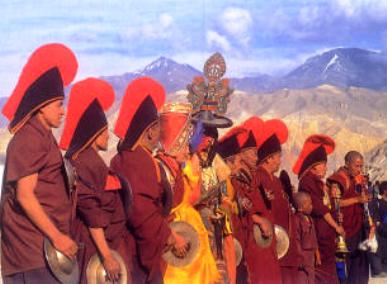
HOW TO GET THERE
Leh airport is 7km from Leh. You can hire taxi at the airport to drive into the city. Leh is connected by air with Delhi, Jammu and Srinagar. The cloud over Leh airport sometimes causes flights to be delayed or cancelled, in which case additional flights are scheduled the next day.
ROAD JOURNEYS
The main overland approach to Ladakh is from the Kashmir Valley via the 434 km Srinagar-Leh road which remains open for traffic from early June to November. The most dramatic part of this road journey is the ascent up the 11,500 feet/3,505 m high Zoji-la, the pass in the Great Himalayan Wall that serves as the gateway to Ladakh. The J&K State Road Transport Corporation (J&K SRTC) operates regular Deluxe and Ordinary bus services between Srinagar and Leh on this route with an overnight halt at Kargil. Taxis (cars and jeeps) are also available at Srinagar for the journey. Groups can charter Deluxe and A-class buses for Leh, Kargil or Padum (Zanskar) from the J&K SRTC at Srinagar.
Since 1989, the 473 km Manali Leh road has been serving as the second land approach to Ladakh. Open fro traffic from around mid-June to early October, this high road traverses the upland desert plateaux of Rupshu whose altitude ranges from 3,660 m to 4,570 m. A number of high passes fall en route among which the highest one, known as Taglang-la, is the world's second highest motorable pass at an altitude of 17,469 feet / 5,325 m. H.P. Tourism, H.P. SRTC and J&K SRTC Operate Deluxe and Ordinary bus services between Manali and Leh. The bus journey between Leh and Manali takes about 19 hours or two days with an overnight halt in camps at Serchu orPang. Gypsy and jeep taxis are also available, both at Manali and Leh.
ACCOMMODATION
Good, clean and reasonable hotels are available.

MONASTERY CIRCUIT: Ladakh monasteries represent four Buddhist sects: Nyingmapa (oldest sect), Drokhpa, Saskyapa and Gelugspa (most recent/widely represented). All the monasteries fall along two routes, and may be covered in two days. Along one route are Shey, Thikse, Stakna, Matto, Chembray, Tak Tok and Hemis. Along the second route (leading out from the airport road) are Spituk, Phyang, Likir, Alchi, Ridzong and Lamayuru: since Lamayuru is 125 km from Leh, you cannot visit the monastery and return to Leh the same day.
Thikse monastery: To attend the morning prayers, take a taxi to Thikse. Nearly 50 monks, six to 60 years old, will be at the Prayers. Prayer timings: 6 am to 7 pm, but early morning is best. Accommodation: At an unpretentious guest house in Thikse village, run by the monastery. Transport: To return to Leh, pre-arrange a taxi from Leh.
Alchi monastery: Take a taxi to Alchi, and keep the taxi overnight. Accommodation: Half a dozen guest houses operate here during peak season.
Stok Palace: The royal family's residence is set in a village 17 km from Leh. The palacemuseum is open in season from 8 am to 7 pm (check timings before visiting).


ZANSKAR, through the Suru Valley and over Pensi La is Zanskar Valley (235 km from Kargil). In remarkable contrast to the valley and Leh district, Zanskar's treeless expanse is the least developed part of Ladakh, with no tourist amenities beyond basic accommodation, and no shopping of any kind at district headquarters, Padum. Zanskar is a rich experience for the trekker who arrives with full provisions. River rafting is possible form Serchu to Nyimu via Padam.
PADUM, headquarters of the Zanskar sub-division of Kargil district, along the only motorable road from Kargil, passing through the picturesque Suru Valley and Panzil Pass (14,400 ft). The road can be used only between early July and end-November. It is also the base for cross-Himalayan treks and trips to the famous monasteries around Zanskar: Karsha (9 km), Stongde (20 km), Burdan (10 km), Zongkhul (20 km) and Phuktal (70 km). Padum has several economy class hotels.
KARGIL is mid-point between Srinagar and Leh. This is where all vehicles going between these two places make a night halt. It is the only other town in Ladakh besides Leh, and is the district headquarters of the region which includes Suru and Zanskar. Access by private cars, taxis and J&K State Road Transport Corporation buses. Kargil is 204 km from Srinagar and 230 km from Leh. Standard accommodation is available at Kargil Continental, D'Zokila, Siachen, Carvan Sarai and Greenland.
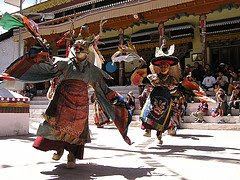
PLEASE REMEMBER!!!
ACCLIMATISATION PRECAUTIONS
You need 36 hours to get acclimatised to the Leh altitude (11,000 ft above sea level). This acclimatisation procedure is essential and ignoring it might lead to medical problems: For 36, or at least 24 hours after you fly into Leh, don't exert yourself physically - that is, relax, lie down, sit. Even returning locals take it easy for a day. Cut down on smoking and avoid alcohol during this period. Drink lots of water to prevent dehydration. Carry at least two small cans of oxygen per family if you journey beyong Leh on excursions up to 18,000 feet as you may experience difficulty in breathing. (Oxygen cans are not available at chemist shops in Leh.)
WHAT TO PACK
At Leh's altitude, the July-August peak season temperature (in the 20s) is actually scorching in the sun and chilly in the shade. Besides, the weather is unpredictable. The clever thing to do is to wear your clothes in layers: cotton T-shirt, thick cotton shirt and jersey, carrying a windcheater for higher altitudes. Expect to peel off a few layers when you are in the sun, and add them when it turns cloudy. Be prepared to do this every little while. It is as important to pack a rick cream and a sunscreen lotion and a wide-brimmed hat. In the off season - May-June and September-October - temperatures range between 4 degrees and 20 degrees - and, happily, there won't be too many tourists around; unhappily, you can't enjoy the trekking, river rafting, monastery festivals or excursions to far off areas (which might be cut short when it snows at the passes).
PROTECTED AREAS
Tourists can drive to these four circuits close to the border - Pangong Lake, Tso Moriri, Nubra Valley and Drokpa - which have recently been opened. However, written permission from the district magistrate's office at Leh is required. The letter of permission must record each detail of the visit: number and names of persons, vehicle registration number, dates of the visit, duration of stay, overnight or day trip. Tourists must carry this letter with them at all times in their vehicles - failure to do so is a criminal offence. Make several photocopies of the letter, so that you can hand over a copy of the letter each to Army personnel at passes and strategic villages, and at checkposts at Changla, Tangtse and the Pangong Lake.
TSO MORIRI (217 km from Leh/overnight excursion): This beautiful lake is ringed by mountains. Accommodation: Tents near the lake arranged by Snow Leopard Adventures of Zangsty, Leh, during the season. Also, tent-cottages of the state's tourism development corporation available on a first-come-first-served basis.
PANGONG TSO (143 km /one-day trip): The lake lies partly in India and partly in China. If you wish, you can camp overnight on the banks of the lake at Spangmik village, the edge of the permitted area for visitors. The Tourism Department has a Hut at Tangtse, but infrastructural facilities are scarce, so you would be wise to take your own camping equipment.
NUBRA VALLEY (18,300 ft/3-day): Nubra Valley is stretched on both sides of the Shyok river. At the pass here you can see snow even in summer. The drive along the world's highest motorable road is so popular that there is a taxi route up to Khardungla. The largest monasteries in the region are at Deskit, the main village, and Sumur. Accommodation: Tents (in peak session) should be reserved in advanced. Many paying guest houses and a PWD Rest House at Deskit. Tents at Tirit. You can stay at J&K Tourism's Hut or one of the private guest houses at Hundar, set within a large sandy desert. Take a sand-dune safari on double-humped Bactrian camels.
THE DROKPA CIRCUIT: The 2,000 Drokpas - who are ethnically, linguistically, spiritually and culturally distinct from the rest of the Ladakhis - live in five villages on the banks of the Indus, near Khaltse. Two of these villages, Dah and Biama (160 km from Leh), are included in the tourist circuit of the Likir, Alchi and Lamayuru monasteries.
